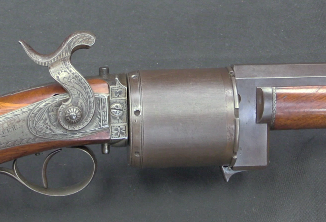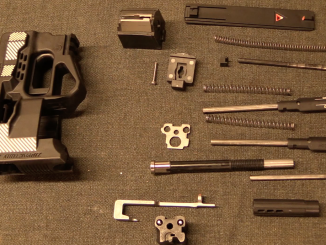Lot 3293 in the September RIA auction.
Patented by Kiel V. Barnekov of New York in 1870, this is a toggle-locked, single shot, open bolt rifle. It was entered into the US 1872 rifle trials which would ultimately select the Allin “Trapdoor” conversion of the Springfield as the next US serve rifle.
Barnekov’s design was intended to be simple and foolproof, although it had real problems in terms of safely carrying and accurately shooting. One would cock the action open and manually insert a cartridge into the chamber. When the trigger was pulled, the action would slam shut, two extractors would ship over the cartridge rim, and it would fire. When the action was then manually re-cocked, the extractors would pull out the empty case and drop it through the open bottom of the receiver, and the gun would be ready to have another round loaded and fired.
Trial records show that the Barnekov rifle was withdrawn from the 1872 testing, and it never appeared elsewhere afterwards. This carbine appears to be a prototype of the system in .45 caliber – perhaps a pistol cartridge. In the formal trials, a full length rifle in .50-70 caliber was submitted.




“Oh no, I just shot Alfred in the knee!” So much for foolproof, if the action is a slam-shut-to-shoot like a particular shotgun we all dislike!
Please view you own video so you can see for yourself how badly the ccaptions obstruct the subject your cooperation in this matter would be greatly appreciated thank you
Joseph Casiano Valcarce: hover over the video, click the sprocket, and turn captions off.
Ian has nothing to do with Youtube’s stupid default settings.
The bad idea fairy never sleeps!
It almost looks like it would need some persuasion to open the breech after firing.
A considerable missed opportunity there. Invert the toggle and change the angle, add a stronger spring, put it on a tripod with a pistol grip and trigger at the rear and a Gatling type tower feed on top, and you could have a crude but effective short-recoil-operated machine gun, predating the Maxim which of course worked on the same principle.
One slight quibble; the Allin conversion or “Trapdoor” breech was first adopted in 1865-66, not 1873. Originally it was used to convert Springfield Model 1861 and 1863 .58 rifle-muskets to first a .58 rimfire and then a .58 centerfire metallic cartridge, using the standard rifle-musket bullet and powder charge.
This was followed in 1867-70 by the .50-70 centerfire version, and in 1872 by the .45-70 cartridge version. There was also a lighter-loaded .45-60 carbine round for the cavalry.
The 1873 trial version, officially adopted in that year, introduced some minor changes to the locking system and extraction system, mainly to simplify production. This was the “definitive” Trapdoor version which was further produced in the 1879, 1884, and 1890 models, with little more than minor changes such as broader breechblock, a different angle to the toggle, and improved rear sights.
The Trapdoor seems to have lasted for almost thirty years (1865 to 1892) simply due to being relatively cheap. Its superiority to other designs of the era was debatable at best.
It was, however, definitely better than this thing.
cheers
eon
I can imagine better safety fo this kind of action: simple lever or stud, physically blocking toggle from closing all the way. Outside portion of it can look like Garand safety or like thumbscrew in front of trigger guard.
But i cant imagine how to fix accuracy and make it working better within dirty enviroment.
And again, Ian made it. I never heard of this design before and if it weren’t for him, i would never have.
Mr. Barnekov seemed to not have collected information about rifle locks. If he had, he would haven’t come up with this design. There were already others way ahead of this.
lnserting a round into the chamber may rise problem at muzzle up shooting. lt seems double extractors were intented to grip the to be fired round between them and hold until discharging and when chambered, slightly to ascend upwards for dropping it after extraction.
It is not well carried thru thought, is it. For one thing, it shows us futility of many “inventing” adventures; they just lead nowhere.
Not directly to subject, but interesting verbal treatise on willingness to kill enemy in combat (assuming designated “enemy” was a true enemy of ours, not a fake enemy)
https://www.youtube.com/watch?v=zViyZGmBhvs
On a side note Cornwall is the name of the town outside the front gate of westpoint.
Sometimes the futility of bad ideas helps to develop the utility of the good ones. There are usually elements of success within the failure. Sometimes learning how to NOT do something is just as important as figuring it out.
An interesting rifle.
Poor reliability.
Poor accuracy.
But cheap and easy to use.
Probably good for the role of a police carbine.
Or “people’s rifle”, if any would be needed.
And further.
I don’t think the grooves inside the receiver are emptying for extractors.
It looks more like the guide slots for the front part of the locking block.
No, though.
There are separate guides there.
https://patents.google.com/patent/USRE4308E/en?inventor=Kiel+V.+Baenekov
Obviously this it really is, for a more reliable holding of brass.